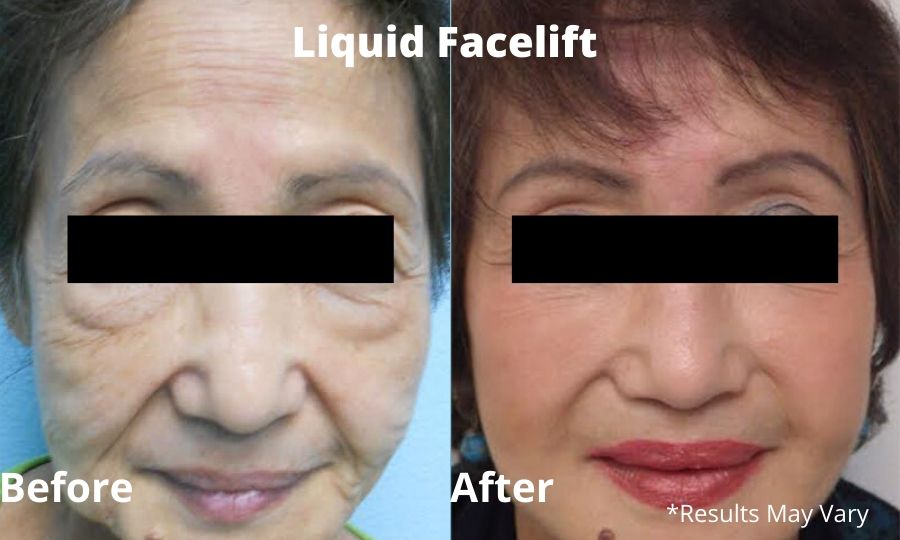February 18, 2020 | 4 minute read
3 Minute Read:
While they are both facelift procedures, the difference between liquid facelifts and surgical facelifts are quite apparent when given a closer look.
To make the most accurate decision on which is right for you, potential facelift candidates must be educated on the similarities and differences between surgical and non-surgical facelift treatments. For example, some of the key aspects that differentiate liquid facelifts and surgical facelifts are safety, cost, convenience, and efficiency.
Liquid facelifts are less expensive, producing subtle changes with a faster procedure time and lesser pain than a traditional facelift. Additionally, liquid facelifts are tailored to the individual to address fine lines, deep wrinkles, creases, sunken cheeks, and loss of volume in the face.
Below you will find a dialogue on the advantages and disadvantages of both traditional surgical facelifts and non-surgical liquid injectable facelifts.
What is a Liquid Facelift, and How Is It Non-Surgical?

Traditional facelifts involve incisions that are made along the hairline to allow for the pulling of tissue beneath the skin. The non-surgical approach of the liquid facelift gives patients a less invasive opportunity to attain increased volume beneath the surface, reverse signs of aging in the grooves of the face, and produce rounded facial contours.
Under intravenous, twilight sedation, Dr. O’Neil masterfully restores volume to targeted areas using a diluted hyaluronic acid and/or the patients fat. This carefully crafted solution is injected into both the surface and deep tissues with a cannula designed to produce significantly less scarring than traditional facelift incisions.
Dr. O’Neil’s sophisticated technique allows him to delicately place each injection in a personalized manner.
What Are the Advantages of the Liquid Facelift Compared to the Surgical Facelift?
Advancements in non-surgical approaches have made these techniques more appealing to patients. After all, the most glaring advantage of a liquid facelift is the ability to get all the necessary benefits of improved facial lines, reversed wrinkles, restored skin elevation, and volume without any surgery.
By removing the need for incisions and only utilizing mild anesthesia, the risk of complications is dramatically reduced, and the expected downtime is minuscule. Patients can expect a massive reduction in their postoperative bruising, making recovery times that much shorter.
Furthermore, the liquid facelift may produce more authentic and natural-looking results for patients as the lost volume and contour is corrected with solutions that fill the face from the inside. This is contrary to the more common “overdone” look that traditional facelifts may create, where the patient’s skin looks constricted, tight, and artificial.
The liquid facelift also prompts zero scarring as the penetration of the cannula does not leave evidence of incision points like surgical knives do.
What Are the Advantages of the Surgical Facelift?
While it is true the progress of non-surgical methods for facelifts continues to advance, there are still some significant advantages to undergoing traditional facelift surgery.
The primary benefit of a surgical facelift is evident in the more dramatic, extensive level of results. Surgical facelifts will cause more scarring, swelling, and require longer recovery time, but the direct relationship between the amount of recovery time and the large-scale balance and corrections in the face are unmatched.
In short, more powerful results will require more invasive procedures with deeper anesthesia and higher risk. Nonetheless, complications with the surgical facelift are remarkably low, if not extremely rare, with complications occurring in less than one percent of cases.
Naturally, these dynamic procedures also produce significantly longer-lasting results than solution-based liquid facelifts. Traditional facelift surgery can last up from anywhere from 10 to 15 years, given the right maintenance, while liquid facelifts will require additional treatments to sustain the results.
Want to Learn More About the Benefits of a Liquid Facelift?
If you would like to learn more about the liquid facelift or see if it may be the right choice for you, please contact Dr. O’Neil for a consultation. We have multiple offices you can reach at 951-296-1690 (Aliso Viejo), 951-296-1690 (Sherman Oaks), or (951) 296-1690 (Temecula).
